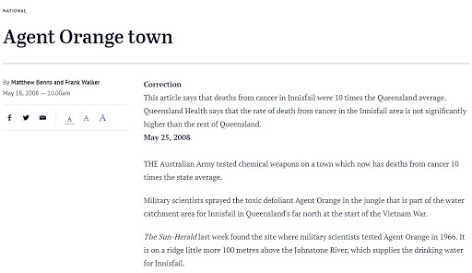The Statement
AAP FactCheck examined a Facebook post titled “Agent Orange town in QLD” which states “The Australian Army tested chemical weapons on a town which now has deaths from cancer 10 times the state average.”
The March 26, 2019 post references a media story written by Matthew Benns and Frank Walker and published on May 18, 2008 in the Sydney Sunday newspaper the Sun Herald.
The story states that in 1966 “military scientists sprayed the toxic defoliant Agent Orange in the jungle that is part of the water catchment area for Innisfail in Queensland’s far north at the start of the Vietnam War”.
The post is accompanied by a photo of an airplane flying over a forest and creating a long spray trail. The post has been shared over 11,000 times and has attracted over 2,400 reactions and over 30 comments.
The Analysis
AAP FactCheck found the photo which accompanies the post was taken in Vietnam in 1962, not in Innisfail, northern Queensland in 1966. It shows a United States Air Force Fairchild UC-123B Provider transport aircraft spraying defoliant in South Vietnam in 1962 during Operation Ranch Hand. The image was sourced to a 1984 book by Dana Bell titled, “Air War over Vietnam”, Volume IV.
The same image has been used a number of times to illustrate the use of Agent Orange in Vietnam by media publications including the Huffington Post and Associated Press in Washington.

According to the US Air Force National Museum, Operation Ranch Hand was a military mission employed during the Vietnam War from 1962 to 1971 to defoliate thick jungle landscape and destroy enemy crops using US Air Force C-123 aircraft to spray millions of gallons of chemicals. In 1965, Ranch Hand began using a very effective defoliant called Agent Orange.
On May 18, 2008, the Sydney Sunday newspaper, the Sun Herald, published a story titled “Agent Orange town” which stated: “Australian Army tested chemical weapons on a town which now has deaths from cancer 10 times the state average. It said military scientists sprayed Agent Orange in an area that is part of the water catchment area for Innisfail in 1966”.
The cancer claim was also disputed by Queensland Health’s Brad McCulloch on May 18, 2008. “There is a 0.1 per cent difference in the rate of which new cancers are diagnosed in Innisfail compared to Queensland,” Mr McCulloch told the ABC.
Then Queensland Premier Anna Bligh told the ABC she would investigate the Agent Orange claims and contact the Federal Government and the Australian Defence Force.
A week after the original story was published on May 25, 2008, a correction was published which stated: “This article says that deaths from cancer in Innisfail were 10 times the Queensland average. Queensland Health says that the rate of death from cancer in the Innisfail area is not significantly higher than the rest of Queensland.” This correction is pasted at the top of the original story but was not included in the Facebook post.
Three weeks after original publication on June 9, 2008 a defence department statement was published by the ABC refuting the claims. The statement read in part. “Our search of archived reports shows that no trials have been carried out by defence scientists in the Innisfail area using Agent Orange. One small scale defoliation trial was conducted in the Gregory Falls area near Innisfail in 1966 to evaluate the effect of herbicides on tropical vegetation. The chemicals used were commonly available at the time. The herbicide 24D, a component of Agent Orange, was not tested.”
According to the Australian cancer atlas, which was released in April 2017, Innisfail has 35 per cent above the national average of excess deaths due to all cancers. The highest incidence of 37 per cent above the national average for excess deaths was due to brain cancer. 34 per cent for lung cancer and 32 for leukemia.
The online cancer atlas also found Queensland had the highest incidence rates for all cancers combined from 2008-2012 (the latest figures available) – a rate of 532 cases of cancer per 100,000 people. It further found people living in remote areas of Australia are 1.2 times more likely to die from all cancers combined compared with major cities. Innisfail is a small regional town in far north Queensland located 100km south of Cairns.
The Australian Cancer Atlas was funded by FrontierSI (formerly the Cooperative Research Centre for Spatial Information), Cancer Council Queensland, Australian Institute of Health and Welfare and Queensland University of Technology.
The Verdict
Based on this evidence AAP FactCheck found the Facebook post titled “Agent Orange town in QLD” was a mixture of true and false claims. The image accompanying the post was from Vietnam not Innisfail. The claim Innisfail was an “agent orange town” was rejected by the defence department. Defence admitted to “one small scale defoliation trial” but claimed it did not contain agent orange. The claim Innisfail had deaths from cancer 10 times the state average was rejected by Queensland Health and corrected by the original publisher. However a cancer study from 2017 found the number of excess deaths due to cancer in Innisfail was 37 per cent above the national average.
Mixture – The Facebook post contains a mixture of true and false claims.
* AAP FactCheck is an accredited member of the International Fact-Checking Network. To keep up with our latest fact checks, follow us on Facebook, Twitter and Instagram.
First published Friday July 24, 2019 11:56 AEST


















